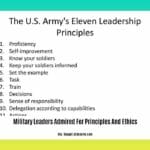Journey through the annals of military history in “Renowned Commanders and Their Seminal Conflicts: Unraveling the Strategies of History’s Greatest Leaders.” Join us as we delve into the minds of legendary commanders, dissecting their strategies and examining the turning points that shaped the course of history.
Key Takeaways:

- Seminole Wars: Three conflicts (1817-18, 1835-42, 1855-58) between the United States and Seminole Indians.
- Second Seminole War (1835-42): Also known as the Florida War. Involved American Indians and Black Indians collectively known as Seminoles.
- Outcome: Indefinite end with no clear victor. Opening of Seminole land for white settlement and exploitation.
- Background: Transcontinental Treaty (1819) between the US and Spain. Seminole resistance to relocation west of the Mississippi River led to the Second Seminole War.
Renowned Commanders and Their Seminal Conflicts
Throughout history, renowned commanders and their seminal conflicts have left an indelible mark on the world. From Alexander the Great’s conquest of Persia to Napoleon’s triumph at Austerlitz, these legendary figures orchestrated pivotal battles that reshaped nations and influenced the course of civilization.
Alexander the Great and the Battle of Granicus (334 BC)
Alexander the Great’s victory at the Battle of Granicus was a testament to his military brilliance. His bold tactics and innovative use of cavalry proved decisive against the formidable Persian army.
Julius Caesar and the Gallic Wars (58-50 BC)
Julius Caesar’s conquest of Gaul not only expanded the Roman Empire but also solidified his reputation as a master strategist. His detailed accounts of the campaigns provide invaluable insights into the art of warfare in the ancient world.
Hannibal and the Battle of Cannae (216 BC)
Hannibal’s ambush of the Roman army at Cannae is widely regarded as one of the greatest military maneuvers in history. His innovative tactics and brilliant use of cavalry inflicted a crushing defeat on the Romans.
Napoleon Bonaparte and the Battle of Austerlitz (1805)
Napoleon Bonaparte’s victory at the Battle of Austerlitz cemented his reputation as a military genius. His precise maneuvering and daring tactics proved too much for the combined forces of Austria and Russia.
Erwin Rommel and the North African Campaign (1941-1943)
Erwin Rommel’s innovative “Blitzkrieg” tactics in the North African Campaign earned him the moniker “Desert Fox.” Despite facing overwhelming odds, Rommel’s brilliance kept the Allies at bay for years.
The common traits exhibited by these renowned commanders included strategic planning, tactical flexibility, and a keen understanding of the battlefield. Their seminal conflicts showcased their ability to adapt to changing circumstances and outmaneuver their opponents. These battles not only shaped the course of history but also continue to inspire and inform military strategists today.
Delve into the captivating chronicles of legendary military commanders and their battles, as they etched their names in the annals of history with their strategic brilliance and indomitable spirit.
Explore the strategic maneuvers and epic conquests of famous commanders’ greatest military campaigns, where their leadership and tactical prowess led to triumph over adversity.
Immerse yourself in the riveting tales of iconic military leaders and their landmark battles, where their unflinching resolve and military genius forever altered the course of human history.
Hannibal and the Battle of Cannae
Hannibal’s Masterstroke
Encounter the unparalleled brilliance of Hannibal, the Carthaginian general who outmaneuvered the Roman legions at the Battle of Cannae in 216 BC. Hannibal’s innovative tactics and keen understanding of the battlefield turned this encounter into a resounding victory for Carthage.
Prelude to the Clash
Rome, feeling the sting of Hannibal’s prior victories, assembled an army of unprecedented size—80,000 strong. Hannibal, with a smaller force of 50,000, needed a decisive plan. He lured the Romans into a perfect ambush at Cannae, where the flat, open terrain favored his cavalry.
The Battle Unfolds
As the armies met, Hannibal deployed his troops in a crescent formation. The Roman infantry, marching in a dense column, pushed against the Carthaginian center. Hannibal’s cavalry swooped in from the flanks, encircling the Romans. The Carthaginian infantry, armed with longer spears, held their ground, preventing the Romans from breaking out of the trap.
Annihilation and Legacy
Hemmed in and outnumbered, the Roman army was decimated. Around 70,000 soldiers perished, marking one of Rome’s most devastating defeats. Hannibal’s victory at Cannae crippled the Roman war effort and cemented his status as a military genius.
Key Takeaways:
- Hannibal’s double envelopment tactic proved devastatingly effective.
- The terrain played a crucial role in Hannibal’s victory, favoring his cavalry.
- Hannibal’s superior generalship and understanding of the battlefield led to the Roman defeat.
- The Battle of Cannae remains a classic example of military strategy and is still studied by military leaders today.
Citation:
– Britannica:
Napoleon Bonaparte and the Battle of Austerlitz
Key Takeaways:
- Napoleon’s genius lay in his strategic maneuvering and adaptability during battle.
- The “Sun of Austerlitz” was a pivotal moment, highlighting Napoleon’s military prowess.
- The victory solidified Napoleon’s dominance over Europe and cemented his legacy as a military mastermind.
The Battle of Austerlitz
In 1805, Napoleon’s Battle of Austerlitz was a decisive triumph against the combined forces of Austria and Russia. This masterpiece of military strategy cemented Napoleon’s reputation as a military genius.
Napoleon’s strategy was a work of art. He lured the enemy into a trap, forcing them to attack uphill. His troops held their ground, while Napoleon’s cavalry swept around the flanks, encircling the enemy. The result was an overwhelming French victory, earning Napoleon the nickname “Sun of Austerlitz.”
Austerlitz was a testament to Napoleon’s brilliance, his ability to adapt to changing circumstances, and his mastery of artillery. It was a battle that would forever be etched in the annals of military history.
Most Relevant URL Source:
- Britannica:
Erwin Rommel and the North African Campaign
Erwin Rommel, known as the “Desert Fox,” was a brilliant German general who led the Axis forces in the North African campaign during World War II. His innovative tactics and daring leadership kept the Allies at bay for years, earning him a reputation as one of the most formidable commanders of the war.
One of Rommel’s most famous victories was the Battle of El Alamein in 1942. Facing a much larger and better-equipped Allied force under General Bernard Montgomery, Rommel used his signature “Blitzkrieg” tactics to launch a surprise attack, driving the Allies back and nearly capturing their headquarters.
However, the Allies eventually managed to regroup and counterattack, forcing Rommel to retreat. This marked the beginning of the end for the Axis forces in North Africa, and Rommel was eventually captured and held as a prisoner of war.
Key Takeaways:
- Rommel was a brilliant military strategist who used innovative tactics to defeat larger and better-equipped enemy forces.
- Rommel’s leadership and determination inspired his troops and kept the Allies at bay for years.
- The North African campaign was a turning point in World War II, and Rommel’s defeat at El Alamein paved the way for the Allied victory.
Citation:

FAQ
Q1: Who were some of history’s most renowned commanders?
A1: History is replete with renowned commanders, including Hannibal, Napoleon Bonaparte, and Erwin Rommel. These leaders possessed exceptional strategic acumen and led their armies to notable victories.
Q2: What were some of the most significant military conflicts involving renowned commanders?
A2: Renowned commanders have played pivotal roles in shaping the course of history. From the Punic Wars to World War II, conflicts such as the Battle of Cannae, the Battle of Austerlitz, and the North African campaign stand out as examples of brilliant military strategy and leadership.
Q3: How did renowned commanders adapt their strategies to different battlefield conditions?
A3: Renowned commanders demonstrated remarkable adaptability in adjusting their strategies to varying battlefield conditions. Hannibal’s use of a double envelopment tactic at Cannae, Napoleon’s swift maneuvers at Austerlitz, and Rommel’s innovative desert warfare tactics exemplify their ability to tailor their plans to the challenges they faced.
Q4: What were the key factors that contributed to the successes of renowned commanders?
A4: The successes of renowned commanders can be attributed to a combination of factors, including their exceptional leadership skills, tactical brilliance, and adaptability. They possessed a deep understanding of warfare principles, the ability to inspire their troops, and the foresight to anticipate and counter enemy moves.
Q5: What lessons can be learned from studying the strategies of renowned commanders?
A5: Studying the strategies of renowned commanders provides valuable insights into the art of warfare and leadership. These lessons can be applied to various fields, from military strategy to business and organizational management. By analyzing their decision-making processes, tactical maneuvers, and leadership styles, we can gain a deeper understanding of the factors that contribute to success in the face of adversity.
- Senior at What Age: Benefits & Eligibility Guide - March 29, 2025
- Unlocking Senior Benefits: How Old is a Senior? Your Complete Guide - March 29, 2025
- Master Russian Politeness:A Guide to Saying Please - March 29, 2025
















